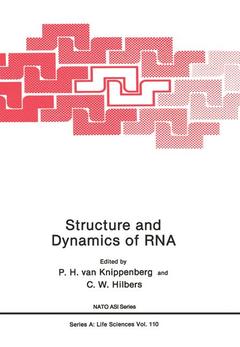Description
Structure and Dynamics of RNA, Softcover reprint of the original 1st ed. 1986
NATO Science Series A: Series, Vol. 110
Authors: Knippenberg P. H. van, Hilbers C. W.
Language: English
52.74 €
In Print (Delivery period: 15 days).
Add to cart
Publication date: 05-2012
348 p. · 17.8x25.4 cm · Paperback
348 p. · 17.8x25.4 cm · Paperback
Description
/li>Contents
/li>
This volume contains contributions from the speakers at the NATO Advanced Research Workshop on "3D 5tructure and Dynamics of RNA", which was held in Renesse, The Netherlands, 21 - 24 August, 1985. Two major developments have determined the progress of nucleic acid research during the last decade. First, manipulation of genetic material by recombinant DNA methodology has enabled detailed studies of the function of nucleic acids in vivo. 5econd, the use of powerful physical methods, such as X-ray diffraction and nuclear magnetic resonance spectroscopy, in the study of biomacromolecules has provided information regarding the structure and the dynamics of nucleic acids. Both developments were enabled by the advance of synthetic methods that allow preparation of nucleic acid molecules of required sequence and length. The basic understanding of nucleic acid function will ultimately depend on a close collaboration between molecular biologists and biophy sicists. In the case of RNA, the ground rules for the formation of secondary structure have been derived from physical studies of oligoribonucleotides. Powerfull spectroscopic techniques have revealed more details of ~~A structure including novel conformations (e.g. left-handed Z-RNA). A wealth of information has been obtained by studying the relatively small transfer RNA molecules. A few of these RNAs have been crystallized, enabling determination of their three-dimensional structure. It has become apparent that "non-classical" basepairing between distal nucleotides gives rise to tertiary interactions, determining the overall shape of the molecule.
Improved Parameters for Prediction of RNA Secondary Structure and Insights into why RNA forms Double Helixes.- Anomalous Conformations of RNA Constituents: 2D NMR and Calculational Studies.- NMR Studies of Base-pair Kinetics of Nucleic Acids.- Picosecond Time Domain Spectroscopy of Structure and Dynamics in Nucleic Acids.- Z-RNA: A Left-handed Double Helix.- A Better Way to Make RNA for Physical Studies.- Mg2+-inner Sphere Complexes at “Ends” and “Bends” of Polynucleotides and their Potential Role as Long Range Inducers of Conformation Changes.- Pseudoknots in RNA: A Novel Folding Principle.- Proton NMR Studies of RNA’s and Related Enzymes Using Isotope Labels.- GU Base Pairs and Variable Loop in Yeast tRNAAsp.- Correlation Between Crystal and Solution Structures in tRNA. Yeast tRNAPhe and tRNAAsp the Models for Free and Messenger RNA Bound tRNAs.- The Solution Structures of RNA Fragments Determined by Nuclear Overhauser Enhancement Measurements.- Molecular Dynamics Simulation of the Anticodon Arm of Phenylalanine Transfer RNA.- Anticodon-Anticodon Interactions and tRNA Sequence Comparison: Approaches to Codon Recognition.- Studies on N Labelled 5S RNA: Assignments in the Helix V Region of 5S RNA, and in the 5S/L25 Complex.- Equilibria in Ribosomal RNA Secondary Structure.- A Comparative Analysis of Structural Dynamics in 5S rRNA.- A Domain of 23S Ribosomal RNA in Search of a function.- The Three-Dimensional Organization of Escherichia coli Ribosomal RNA.- The Extremely Small Mitochondrial Ribosomal RNAs from Trypanosomes.- Mutagenesis of Ribosomal RNA as a Method to Investigate Interactions Between rRNA, mRNA and tRNA.- Ribosomal RNA at the Decoding Site of the tRNA-Ribosome Complex.- Double Stranded RNA in the Decoding of the mRNA by the Bacterial Ribosome.-Conformational Dynamics Involved in RNA Self-Splicing.- RNA Catalyzed Lariat Formation from Yeast Mitochondrial Pre-Ribosomal RNA.- Viroids: Structure Formation and function.- Author Index.
© 2024 LAVOISIER S.A.S.
These books may interest you

Nucleic Acids and Molecular Biology 105.49 €



